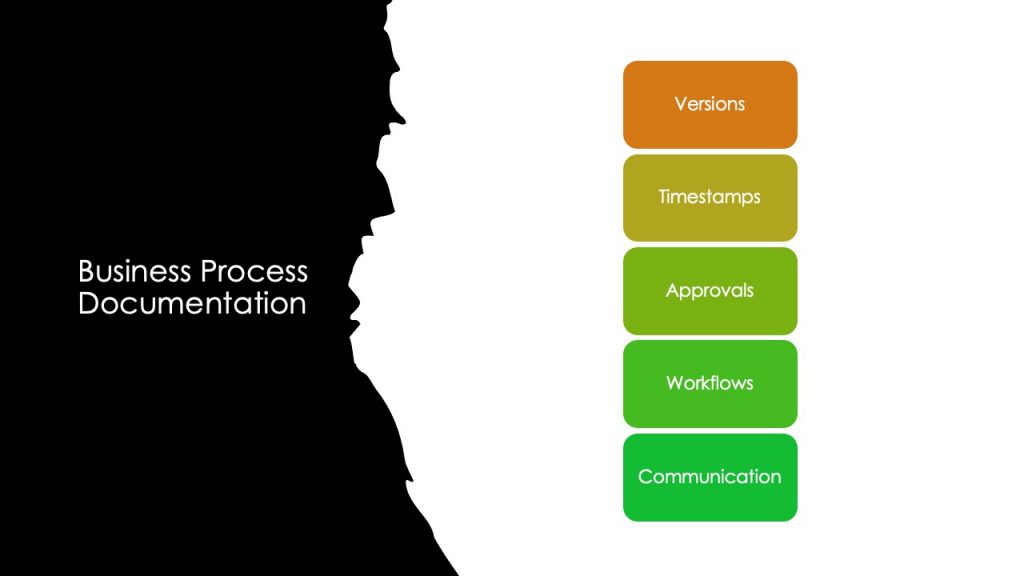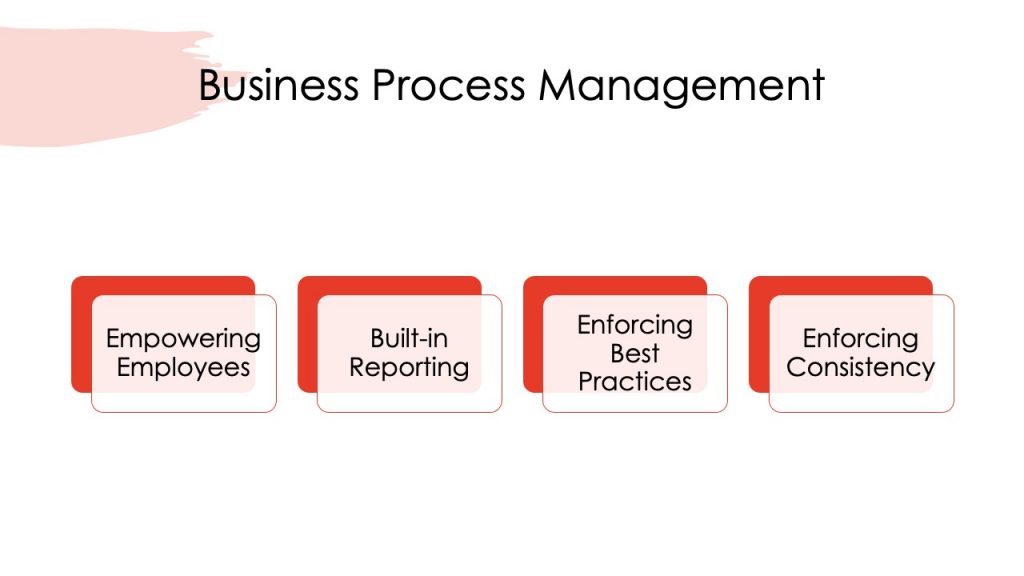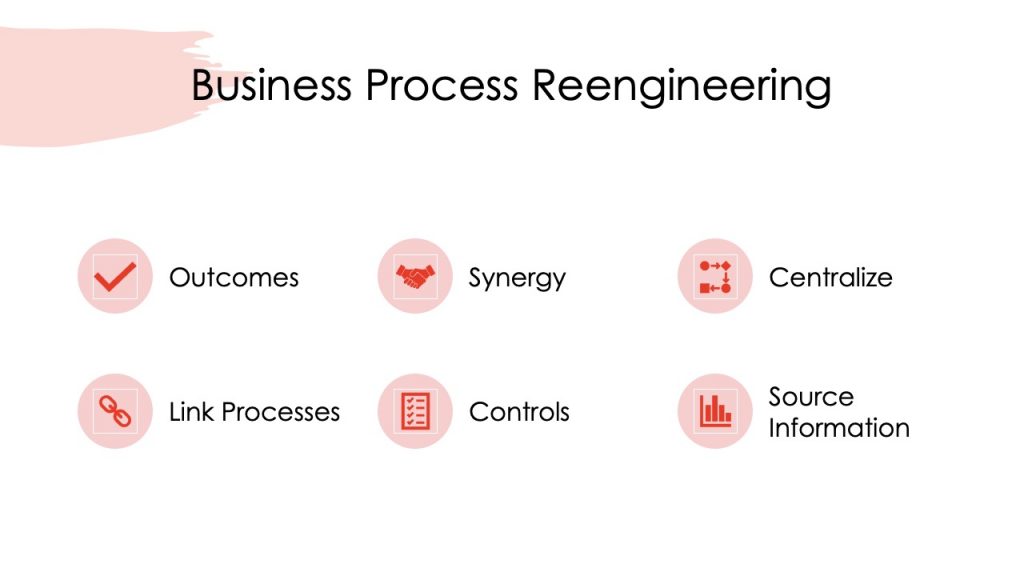7 Chapter 7 – Processes and Workflows
Learning Objectives
7.1 Define a Business Process
7.2 Describe Business Process Documentation
7.3 Understand Business Process Management
7.4 Understand Business Process Reengineering
The fourth component of information systems is process. But what is a process and how does it tie into information systems? And in what ways do processes have a role in business? This chapter will look to answer those questions and also describe how business processes can be used for strategic advantage.
What is a business process?
We have all heard the term process before, but what exactly does it mean? A process is a series of tasks that are completed in order to accomplish a goal. A business process, therefore, is a process that is focused on achieving a goal for a business. If you have worked in a business setting, you have participated in a business process. Anything from a simple process for making a sandwich at Subway to building a space shuttle utilizes one or more business processes.
Processes are something that businesses go through every day in order to accomplish their mission. The better their processes, the more effective the business. Some businesses see their processes as a strategy for achieving competitive advantage. A process that achieves its goal in a unique way can set a company apart. A process that eliminates costs can allow a company to lower its prices (or retain more profit).
Documenting a process
Every day, each of us will conduct many processes without even thinking about them: getting ready for work, using an ATM, reading our e-mail, etc. But as processes grow more complex, they need to be documented. For businesses, it is essential to do this, because it allows them to ensure control over how activities are undertaken in their organization. It also allows for standardization: McDonald’s has the same process for building a Big Mac in all of its restaurants.
The simplest way to document a process is to simply create a list. The list shows each step in the process; each step can be checked off upon completion. For example, a simple process, such as how to create an account on eBay, might look like this:
1. Go to ebay.com.
2. Click on “register.”
3. Enter your contact information in the “Tell us about you” box.
4. Choose your user ID and password.
5. Agree to User Agreement and Privacy Policy by clicking on “Submit.”
For processes that are not so straightforward, documenting the process as a checklist may not be sufficient. For example, here is the process for determining if an article for a term needs to be added to Wikipedia:
1. Search Wikipedia to determine if the term already exists.
2. If the term is found, then an article is already written, so you must think of another term. Go to
3. If the term is not found, then look to see if there is a related term.
4. If there is a related term, then create a redirect.
5. If there is not a related term, then create a new article.
This procedure is relatively simple – in fact, it has the same number of steps as the previous example – but because it has some decision points, it is more difficult to track with as a simple list. In these cases, it may make more sense to use a diagram to document the process.
Managing business process documentation
As organizations begin to document their processes, it becomes an administrative task to keep track of them. As processes change and improve, it is important to know which processes are the most recent. It is also important to manage the process so that it can be easily updated! The requirement to manage process documentation has been one of the driving forces behind the creation of the document management system. A document management system stores and tracks documents and supports the following functions:
• Versions and timestamps. The document management system will keep multiple versions of documents. The most recent version of a document is easy to identify and will be served up by default.
• Approvals and workflows. When a process needs to be changed, the system will manage both access to the documents for editing and the routing of the document for approvals.
• Communication. When a process changes, those who implement the process need to be made aware of the changes. A document management system will notify the appropriate people when a change to a document is approved.
Of course, document management systems are not only used for managing business process documentation. Many other types of documents are managed in these systems, such as legal documents or design documents.

Business process management
Organizations that are serious about improving their business processes will also create structures to manage those processes. Business process management (BPM) can be thought of as an intentional effort to plan, document, implement, and distribute an organization’s business processes with the support of information technology.
BPM is more than just automating some simple steps. While automation can make a business more efficient, it cannot be used to provide a competitive advantage. BPM, on the other hand, can be an integral part of creating that advantage.
Not all of an organization’s processes should be managed this way. An organization should look for processes that are essential to the functioning of the business and those that may be used to bring a competitive advantage. The best processes to look at are those that include employees from multiple departments, those that require decision-making that cannot be easily automated, and processes that change based on circumstances.
To make this clear, let’s take a look at an example.
Suppose a large clothing retailer is looking to gain a competitive advantage through superior customer service. As part of this, they create a task force to develop a state-of-the-art returns policy that allows customers to return any article of clothing, no questions asked. The organization also decides that, in order to protect the competitive advantage that this returns policy will bring, they will develop their own customization to their ERP system to implement this returns policy. As they prepare to roll out the system, they invest in training for all of their customer-service employees, showing them how to use the new system and specifically how to process returns. Once the updated returns process is implemented, the organization will be able to measure several key indicators about returns that will allow them to adjust the policy as needed. For example, if they find that many women are returning their high-end dresses after wearing them once, they could implement a change to the process that limits – to, say, fourteen days – the time after the original purchase that an item can be returned. As changes to the returns policy are made, the changes are rolled out via internal communications, and updates to the returns processing on the system are made. In our example, the system would no longer allow a dress to be returned after fourteen days without an approved reason.
If done properly, business process management will provide several key benefits to an organization, which can be used to contribute to competitive advantage. These benefits include:
• Empowering employees. When a business process is designed correctly and supported with information technology, employees will be able to implement it on their own authority. In our returns-policy example, an employee would be able to accept returns made before fourteen days or use the system to make determinations on what returns would be allowed after fourteen days.
• Built-in reporting. By building measurement into the programming, the organization can keep up to date on key metrics regarding their processes. In our example, these can be used to improve the returns process and also, ideally, to reduce returns.
• Enforcing best practices. As an organization implements processes supported by information systems, it can work to implement the best practices for that class of business process. In our example, the organization may want to require that all customers returning a product without a receipt show a legal ID. This requirement can be built into the system so that the return will not be processed unless a valid ID number is entered.
• Enforcing consistency. By creating a process and enforcing it with information technology, it is possible to create a consistency across the entire organization. In our example, all stores in the retail chain can enforce the same returns policy. And if the returns policy changes, the change can be instantly enforced across the entire chain.

Business process reengineering
As organizations look to manage their processes to gain a competitive advantage, they also need to understand that their existing ways of doing things may not be the most effective or efficient. A process developed in the 1950s is not going to be better just because it is now supported by technology.
In 1990, Michael Hammer published an article in the Harvard Business Review entitled “Reengineering Work: Don’t Automate, Obliterate.” This article put forward the thought that simply automating a bad process does not make it better. Instead, companies should “blow up” their existing processes and develop new processes that take advantage of the new technologies and concepts. He states in the introduction to the article:1
Many of our job designs, workflows, control mechanisms, and organizational structures came of age in a different competitive environment and before the advent of the computer. They are geared towards greater efficiency and control. Yet the watchwords of the new decade are innovation and speed, service, and quality.
It is time to stop paving the cow paths. Instead of embedding outdated processes in silicon and software, we should obliterate them and start over. We should “reengineer” our businesses: use the power of modern information technology to radically redesign our business processes in order to achieve dramatic improvements in their performance.
Business process reengineering is not just taking an existing process and automating it. BPR is fully understanding the goals of a process and then dramatically redesigning it from the ground up to achieve dramatic improvements in productivity and quality. But this is easier said than done. Most of us think in terms of how to do small, local improvements to a process; complete redesign requires thinking on a larger scale. Hammer provides some guidelines for how to go about doing business process reengineering:
• Organize around outcomes, not tasks. This simply means to design the process so that, if possible, one person performs all the steps. Instead of repeating one step in the process over and over, the person stays involved in the process from start to finish.
• Have those who use the outcomes of the process perform the process. Using information technology, many simple tasks are now automated, so we can empower the person who needs the outcome of the process to perform it. The example Hammer gives here is purchasing: instead of having every department in the company use a purchasing department to order supplies, have the supplies ordered directly by those who need the supplies using an information system.
• Subsume information-processing work into the real work that produces the information. When one part of the company creates information (like sales information, or payment information), it should be processed by that same department. There is no need for one part of the company to process information created in another part of the company.
• Treat geographically dispersed resources as though they were centralized. With the communications technologies in place today, it becomes easier than ever to not worry about physical location. A multinational organization does not need separate support departments (such as IT, purchasing, etc.) for each location anymore.
• Link parallel activities instead of integrating their results. Departments that work in parallel should be sharing data and communicating with each other during their activities instead of waiting until each group is done and then comparing notes.
• Put the decision points where the work is performed and build controls into the process. The people who do the work should have decision-making authority and the process itself should have built-in controls using information technology.
• Capture information once, at the source. Requiring information to be entered more than once causes delays and errors. With information technology, an organization can capture it once and then make it available whenever needed.
These principles may seem like common sense today, but in 1990 they took the business world by storm. Hammer gives example after example of how organizations improved their business processes by many orders of magnitude without adding any new employees, simply by changing how they did things.

ISO certification
Many organizations now claim that they are using best practices when it comes to business processes. In order to set themselves apart and prove to their customers (and potential customers) that they are indeed doing this, these organizations are seeking out an ISO 9000 certification. ISO is an acronym for International Standards Organization (website here). This body defines quality standards that organizations can implement to show that they are, indeed, managing business processes in an effective way. The ISO 9000 certification is focused on quality
In order to receive ISO certification, an organization must be audited and found to meet specific criteria. In its most simple form, the auditors perform the following review:
- Tell me what you do (describe the business process).
- Show me where it says that (reference the process documentation).
- Prove that this is what happened (exhibit evidence in documented records).
Over the years, this certification has evolved, and many branches of the certification now exist. ISO certification is one way to separate an organization from others. You can find out more about the ISO 9000 standard here.
Chapter 7 Assignment
OVERVIEW
This assignment is designed to introduce you to the creation of rules that govern most systems.
Create a list of rules (and explain your reasoning) for the qualification of students for a university scholarship. Examples can be found at https://fhsu.edu/finaid/scholarships/index.
STEPS/QUESTIONS
You are going to create a new scholarship for FHSU students and need to decide on the rules that will qualify students for the scholarship.
- Pick 3 to 4 questions/qualifications (such as academic rank, GPA, etc.) that could be used to help decide which student(s) would qualify for the scholarship.
- Create ‘rules’ for these qualifications that would automate decision making. Explain the rationale for each rule.
- Now for each rule, come up with a scenario where the rule may disqualify a student although they should still be included (for example, a student that is 1 hour short of being a senior, but the next academic year would be the student’s senior year). How should this be handled?
GRADING
A satisfactory submission will outline the rules for a scholarship and give examples of possible failures for each rule.
A beyond satisfactory submission will likely establish the basis for each rule and explain expected ‘failures’ while introducing procedures to handle such failures. A discussion and explanation are expected.

